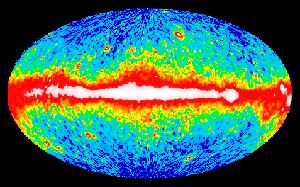
AMS can help on the high-energy end. AMS can detect high-energy gamma rays - these are photons so energetic that they can actually "manufacture" mass when they crash into something. A gamma ray crashing into AMS can produce an electron and a positron, which are charged particles, so AMS measures them normally. AMS can actually take images of the sky and see where the gamma rays are coming from - just like a telescope. The "flux" of these particles is very low, but even a single ultra-high-energy gamma ray can identify an interesting astrophysical source.
AMS's calorimeter also can identify gamma rays, although its direction sensitivity is not so good.
(back to top) - (back to AMS Tour)